In this article we will explore expert advice to answer your question, why do I have knee pain while squatting?
Many gym enthusiasts experience knee pain while squatting in their lives. But before you blame the squat and avoid this excellent functional exercise altogether, I recommend that you read this blog!
First we want to identify the root cause of your knee pain and then explore how to treat the cause through a functional (movement) approach rather than only the symptom that clinical environments offer.
This way, you will be on your way to a pain-free squat! Let’s dive in!
Contents
- 1 Common Causes of Knee Pain While Squatting
- 2 Medical Approach
- 3 Examples of Clinical Diagnosis for Knee Pain
- 4 How to Treat Knee Pain While Squatting
- 5 Strengthen the Glutes
- 6 Strengthen the Quads and Hamstrings
- 7 Strengthening Your Hamstrings
- 8 Improve Hip, Knee and Foot Stability
- 9 Clear Ankle Mobility Restrictions
- 10 Focus on Your Squat Technique
- 11 Conclusion
- 12 FAQs
Common Causes of Knee Pain While Squatting
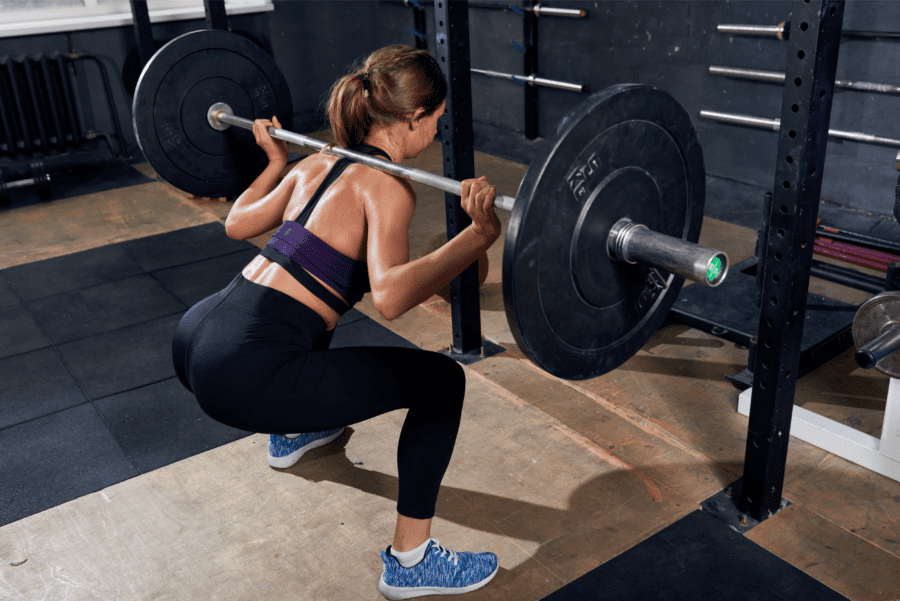
To understand your knee pain while squatting better, it’s essential for you to understand what causes it and differentiate the functional approach or movement issues from the medical diagnosis. They are both very important in their own unique way!
Functional approach
To identify movement issues, this treatment often starts with movement, postural assessment to evaluate what brings out your knee pain while squatting.
An accredited Sports Massage Therapist or Strength and Conditioning coach will assess your movement during a postural assessment. They will then develop a personalised exercise plan to treat the root cause of your knee pain while squatting.
Common causes of knee pain include:
- Mobility restrictions
- Strength imbalances
- Muscle weakness
- Movement compensation
- Limited range of motion
The sports massage therapist or specialist level 4 personal trainer will then treat it by:
- Clearing mobility restrictions and restoring the structures.
- Clearing side-to-side strength imbalances and restoring the function and activating the muscles.
- Helps gaining strength within the newly acquired range of movement. Restoring strength, specifically for squatting.
- Helps restore sport-specific performance through dynamic and reactive movement, deceleration, and acceleration (for athletes).
Examples of Movement Related Knee Pain
If you have weak Gluteus Medius (side buttocks muscle), which are the primary stabilisers of the hips, other muscles like the Iliotibial Band will need to overtake their role.
While the job of the Iliotibial band is to assist in pelvic stabilisation and posture control, it’s not the ‘boss’ to serve this purpose! So you will develop movement compensation and squat with bad technique!
Because of the constant work the IT band needs to do, it will then become tight, the foot will pronate (drop inward) and these will put excessive stress on the knee joint, tendon and ligaments!
The IT band connects to the knee joint (laterally) and helps provide stability. It can rub repeatedly against the lower end of your thigh bone, causing irritation and knee pain while squatting.
If we want to treat this lateral knee pain from the roots with a functional approach, we need to strengthen the Gluteus Medius muscle and learn adequate foot stability through single-leg exercises and proprioception.
Medical Approach
Clinical treatment, however, will look at the state of the structures like ligaments, bones, muscles, and cartilage with MRI scan, X-ray and physical examination of the tissue and aims for diagnosis.
This approach is critical after traumatic events, falls, wear and tear accidents, and other severe cases of knee pain like torn ACL, meniscus tear, cartilage damage, baker cyst, and many more. These may require surgical procedures or other clinical interventions.
Steroid injections, painkillers like Ibuprofen are another option which may be used within any medical support plan. They might give you relief to reduce inflammation in your joints or tendons, allowing you to complete your (physical therapy) leg exercises. So sometimes both approaches are needed.
We would not recommend returning to heavy squatting after steroid injections but starting off with a professionally designed rehabilitation and training plan. Just because you don’t feel the pain, does not mean the cause is fixed, but that the symptoms are eased through drugs and medication!
While medical treatment is necessary in some cases, weightlifters, gym enthusiasts, bodybuilders, active people, and other strength training athletes often experience knee pain while squatting because of movement dysfunction rather than traumatic events.
Examples of Clinical Diagnosis for Knee Pain
Let’s explore the most common causes of knee pain.
Iliotibial Band Syndrome
The lateral knee pain results from gluteus medius weakness that fails to stabilise the pelvis. It can also occur from a sudden increase in activity or excessive foot pronation.
However, it’s called IT band syndrome by clinical diagnoses, and you may be asked to rest.
Patellofemoral Pain Syndrome/ Runner’s Knee
If you have a dull ache in front of your knee while squatting, behind the knees when sitting for a long time, you may get diagnosed with runner’s knee (PFPS).
But to treat the cause of this diagnosis you should strengthen your glutes and clear mobility restrictions like hip internal and external rotation. This can eliminate your knee pain while squatting.
Knee Osteoarthritis
Knee Osteoarthritis is when the cartilage in the knee wears out, and the bones rub together!
If you can not precisely locate your joint pain or it feels worse in the morning after waking up, swollen, makes a cracking noise, has sharp pain while or after squatting, feels unstable and wobbly with a reduced range of movement and stiffness, you may be dealing with osteoarthritis.
You can’t build cartilage but you can strengthen the muscles around the knees help support the knees and prevent this condition deteriorating further.
Loss of proprioception (lack of neuromuscular control) and quadriceps weakness has been associated with developing knee osteoarthritis.
Therefore, strengthening the quads and doing balancing exercises is necessary to reduce or prevent knew osteoarthritis developing.
Modifying squatting style and depth can allow you to perform squats even with knee Osteoarthritis. On some occasions, surgical treatment is necessary.
Jumper’s Knee / Patellar Tendonitis
Jumper’s knee or patellar tendonitis, is the inflammation of the patellar tendon located between the shinbone and the kneecap. It is caused by sport-related overuse injuries, like constant jumping, as the name suggests! If you feel pain and tenderness around your tendon (patella) it is more likely you have tendonitis.
With functional treatment, we need to strengthen the tendon, to increase its tolerance and reduce inflammation. Therefore, performing Bulgarian splits squats and touch down squats before doing any plyometrics and jumping is essential exercise that can support you to reduce knee pain while squatting.
How to Treat Knee Pain While Squatting
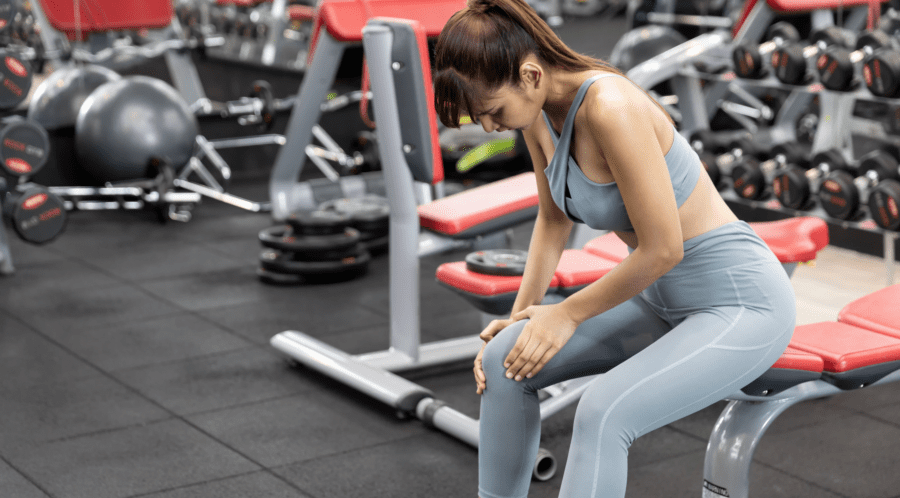
Now that we know the cause of a few knee issues that can result in knee pain while squatting, it is time to explore what we can do to treat it.
The information and advice this blog provides are general and should not replace professional or medical assistance. If your knee pain worsens, it is essential to consult with your doctor or healthcare professional. Additionally, seeking medical advice before beginning any exercise program.
Clear Hip Internal Rotation
Sedentary lifestyle, repetitive movement can lead to a limited range of movements, just like hip internal rotation. This can interfere with your squatting mechanics, especially at a 90-degree angle when the hip rotates internally.
Limited hip internal rotation will put unnecessary load on the knees, restricting the femur from moving in the ball and socket adequately, increasing the risks of knee pain while squatting!
To treat first, you should test, then retest and see how the exercises make a difference. You don’t want to do something without gaining benefit from it. So always test and retest.
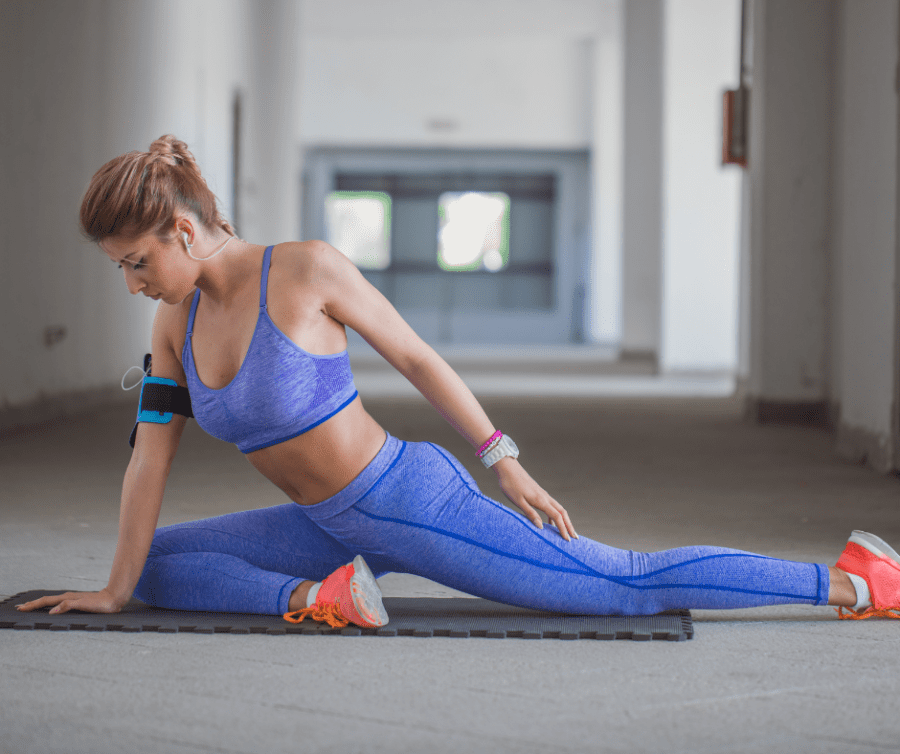
Testing Hip Internal Rotation
You should have at least 30 degrees of rotation on each leg. Also, there shouldn’t be a difference between the two sides. If you found side-to-side differences or had no hip rotation, complete the following exercises at home, before squatting, or anytime you want to for 1 minute!
Exercises to Clear Hip Internal Rotation
- 90/90 Drill
- Banded Mobilisation:
- Deep Squat Hold
Strengthen the Glutes
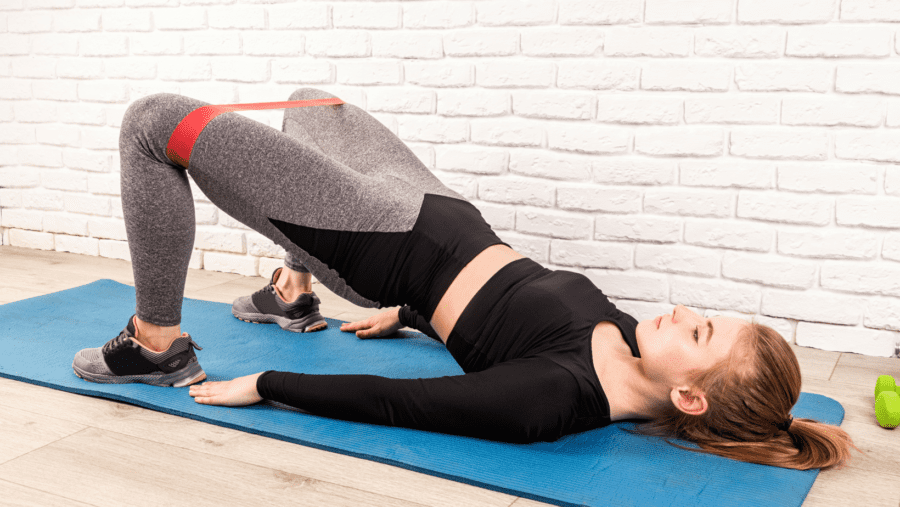
The gluteus medius is crucial in maintaining stability and proper knee and hip alignment during squatting. It functions as a hip abductor, preventing the knees from dropping inward (knee valgus) during the squat.
Weak glutes, therefore, can put unnecessary load on the knees, causing pain while squatting and other issues like IT Band Syndrome and Patellofemoral Pain Syndrome.
Testing for Glutes Weakness
The starting point for strengthening your glutes will be to test for weakness, like this test which can be done to test for strength imbalances.
If you find significant strength imbalances between your right and left side glutes, you will need to strengthen it.
Exercises to Strengthen the Glutes
Complete 2-3 sets of 10-12 slow controlled reps of each exercise on each side!
- Banded Clam Shell: Gluteus Medius Hip Muscle Strength Test
- Sidekicks: How to Do an Up & Down Side Kick | Pilates Workout
- Bridge: How to Perform the Perfect Glute Bridge
Stay consistent with these exercises, and implement it into your workout routine. As you get stronger progress from body weight to weighted or banded. If you are thinking about hiring a personal trainer to support you with your workout plan then they should conduct their own initial analysis and programme exercises in to support strengthening the glutes.
Strengthen the Quads and Hamstrings
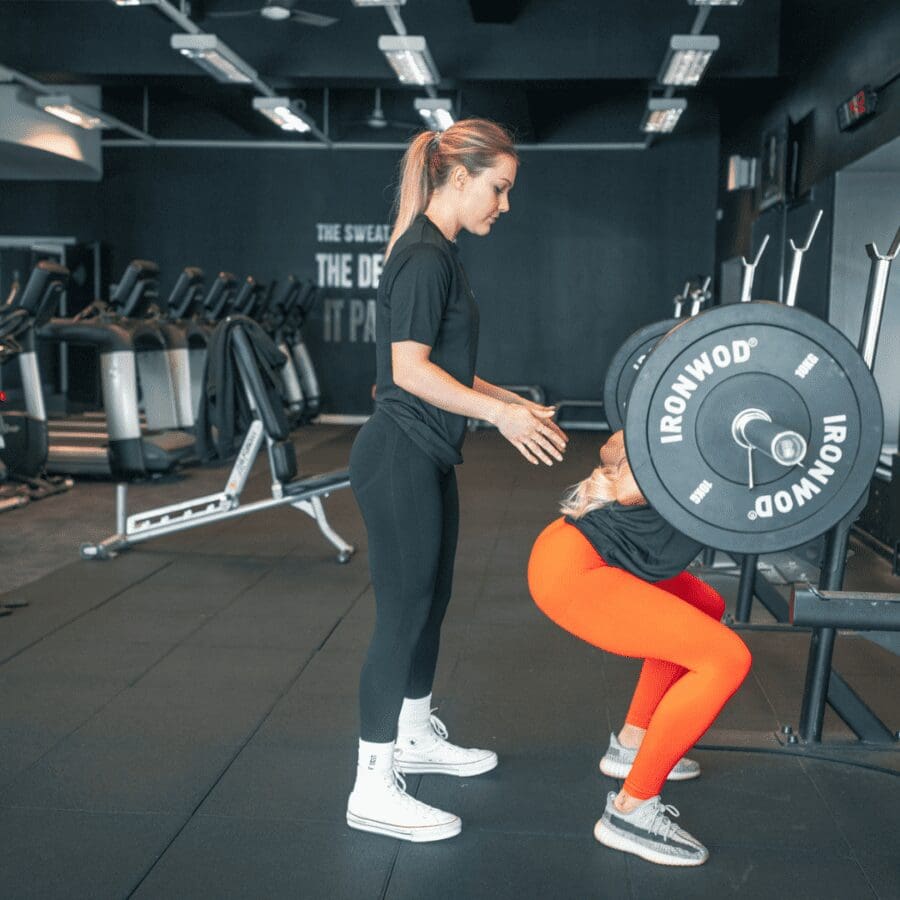
We know that weak quads can result in knee osteoarthritis, while weak tendons can result in patellar tendonitis.
During squats, the quads carry out knee extension on the way up (concentric) and control knee flexion in the lowering phase (eccentric).
So having strong quads and leg muscles are both essential for a healthy squat.
Testing Your Quad Strength
First, like with the glutes you should first test your quad strength. This simple test seen in the video below allows your personal trainer or sports massage therapist to broadly identify any weakness and rate it on a simple scale.
If you were unable to resist during this strength test, we recommend you complete the some exercises to aid with the goal of building strength in your quads. You could start with some of the below exercises for 2-3 sets of 10-12 reps.
Strengthening Exercises for The Quadriceps
Strengthening Your Hamstrings
We also recommend assessing your hamstring and quad strength ratio. There is often strength differences between the hamstring and quads and this can put you at higher risk of ACL (ligament) injuries.
Studies show that female athletes with weak hamstrings are more prone to ACL injuries.
Testing Your Hamstring Strength
First, like as described with both the glutes and quads, you should first test your hamstring strength. Once again this simple test in the video below allows your coach or therapist to broadly identify any weakness and rate it on a simple scale.
Our Level 4 Sports Massage Qualification will support you with the knowledge so you can identify any muscular weaknesses and conduct postural assessments with clients.
If you find a Right and Left side difference in strength, complete these exercises for 2-3 sets of 12 reps with a 5 seconds lowering (eccentric) phase.
Strengthening Exercises for The Hamstrings
Improve Hip, Knee and Foot Stability
By improving overall stability your feet will stay flat and stable on the ground without pronating or supinating, and your hip muscles will fire at the right time, improving your balance and stability during squatting and taking the load off the knee joint!
Exercises to Improve Overall Stability
Complete these exercises for 1-2 sets of 10 reps
If you identify that you have knee osteoarthritis we also recommend wearing knee straps, or bands while squatting. This can help increase your proprioception within the joint through compression.
Clear Ankle Mobility Restrictions
If you have limited ankle mobility, your feet may pronate (drop inwards) and put excessive load on the knees during squats. You will also have reduced squat depth, and your back may try to compensate with butt wink (the butt curling under you).
This overtime can lead to knee pain while squatting, knee pain after squats, and other musculoskeletal pains like lower back pain.
Testing for Limited Ankle Mobility
The Weight Bearing Lunge Test or Wall Test is a great exercise to complete to test for limited ankle mobility (seen in the video below).
If you find a difference between the right and left side ankles, then you can perform the some simple exercises like ankle foam rolling and banded ankle joint mobilisation.
Improve Tibial Rotation
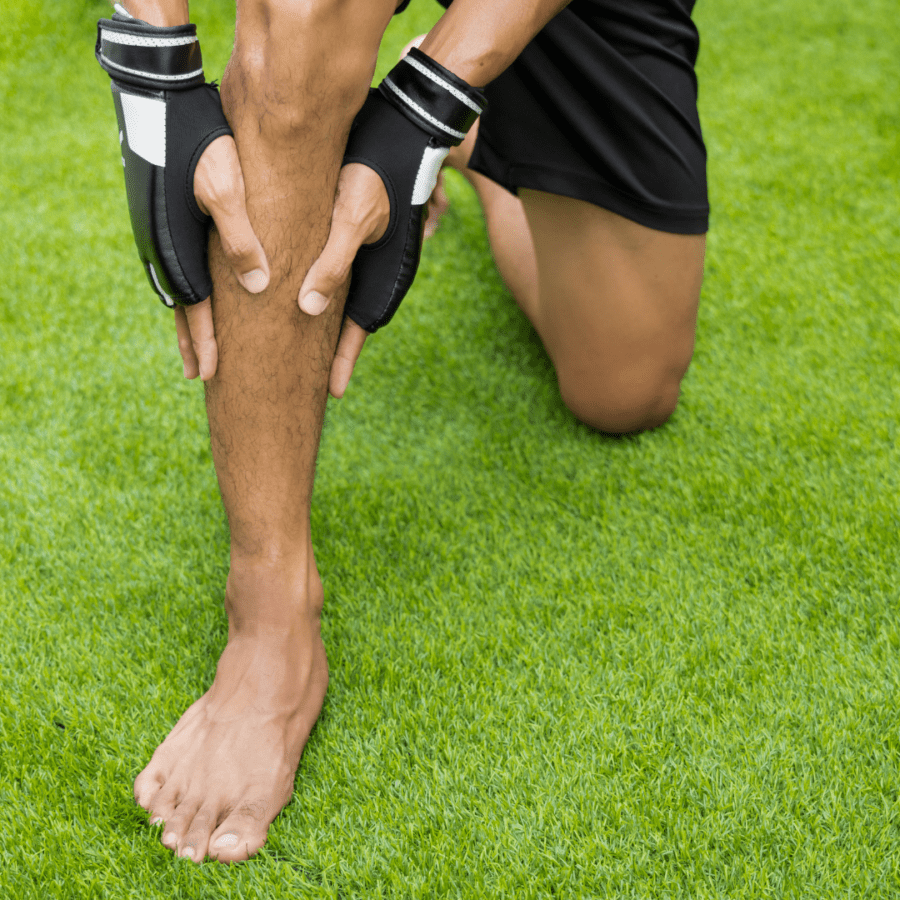
The tibia (shin bone) internally rotates during a squat. This is important because with adequate tibial rotation you can maintain proper knee and ankle over toes alignment, reducing stress on the knees!
Testing for Limited Tibial rotation and Knee Pain
If you found limitation, complete the exercises below for 1 minute
Exercise to Improve Tibial Rotation
Tibial Rotation: Improve Your Tibial Rotation
Add sports massage, foam rolling, soft tissue release and kinesiology taping to your routine
Soft tissue release, sports massage, and foam rolling are great ways to ease muscle tension and tightness. It increases blood flow, speeds up recovery, and can be a great addition to your rehabilitation for knee pain while squatting.
I especially recommend kinesiology taping for those experiencing IT band syndrome. It reduces swelling and pain and speeds up your healing by improving blood circulation!
Look for a qualified professional to provide these treatments for you.
Warm-up and Cool-down before squatting
Complete a full and effective warm-up, such as RAMP Warm-Up. Your warm up will help you increase heart rate and body temperature. It loosens your joints, aiding in better mobility, which is crucial for squatting. It also activates the muscles to fire when they are the most needed.
Some warm-up exercises include 5-minute jog on the treadmill with gradually increased speed, dynamic stretches, and activation exercises, such as:
- Leg swings
- Squat to Overhead Reach
- World’s Greatest Stretch
- Bridges
- Walk Outs
- Bande Marching
- Lateral Mini Band Walks
- Thoracic rotations
Completing warm up can reduce your risk of injury and avoid your current and old ones to flare up.
Cool downs reduce your heart rate and body temperature and regulate your blood flow which can speed up your recovery. This can include a 5 minute walk on a treadmill at a slow pace and some static stretches.
If you skip your warm up and cool downs, your pain might develop gradually by suddenly overloading the tissues around your knees.
Focus on Your Squat Technique
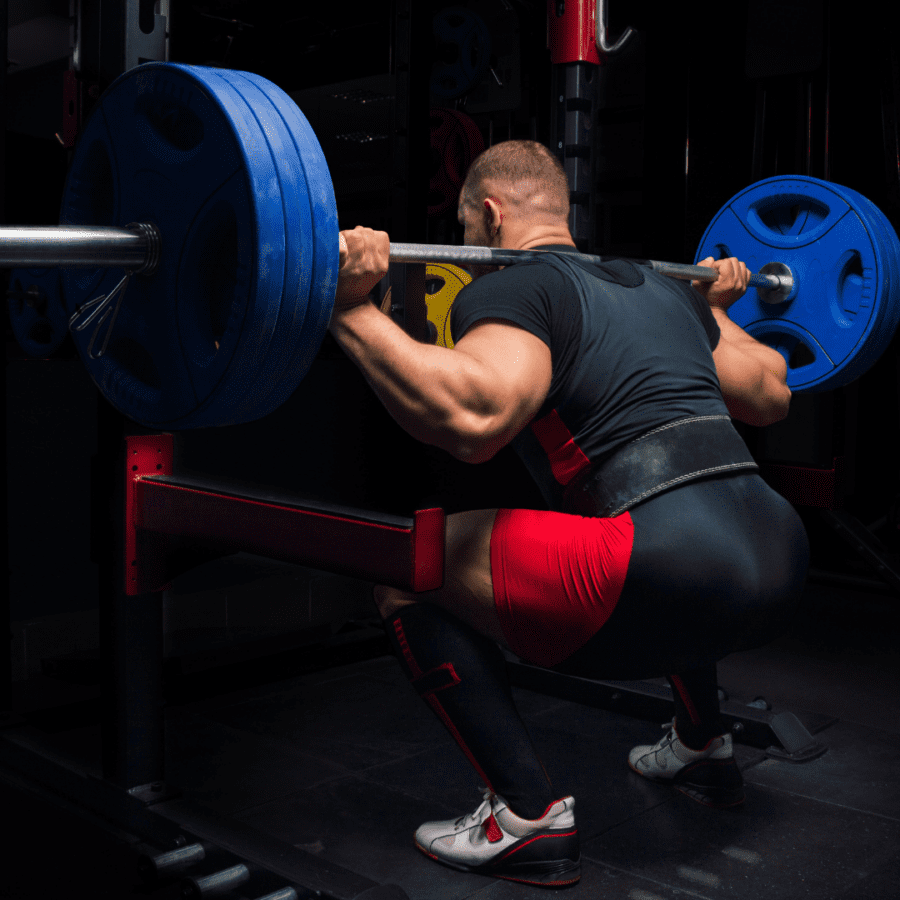
If you have tested for all mentioned issues above and didn’t notice any problems, you may be out of ideas! I left last but not least your squatting technique. Improper squatting technique will cause uneven forces transferring through the knees resulting in knee pain while squatting!
How to Barbell Squat Correctly:
- Get under the bar with both hands grabbing the barbell and the bar resting on the top of your traps.
- Stand under the bar with your feet hip-width apart, to gain balance before lifting the bar off the rack.
- Once the bar is in a safe position and you are stable, stand up straight and lift the bar off the rack!
- Star stepping back, away from the column bar.
- Find the correct stance position for your anatomy and mobility level.
- Pull the elbow down and secure the bar on your shoulders before squatting.
- Engage the core, the glutes and take a deep breath.
- Start lowering down by hinging on the hip, like sitting down on a chair.
- Maintain a slight forward torso position (back of your shoulders aligned with your mid foot).
- Keep your feet flat, like a tripod (tripod foot).
- Once you reach your maximum squat depth (ideally 90 degrees or more), push through your feet and return to the starting position.
Here are a few pieces of advice to watch out for before you jump under the bar again!
- When you breath in on the top before performing the squat, do NOT let the air up until you perform the full reps. Instead exhale on the bottom position 10-15% of the air. This way you can maintain internal pressure and keep your core stable and the spine safe (Valsalva manoeuvre).
- There is no one size fits all when it comes to squatting stance. Your stance depends on your anatomy and mobility level. Therefore play around with your foot position and find the one which makes your squatting technique optimal.
- Avoid ego lifting. Gradually progress the weight as you get better at squatting, especially if you are already experiencing knee pain.
Conclusion
Knee pain while squatting can be the result of compensatory movements, mobility restriction and strength imbalances. We can develop these through repetitive movement and prolonged sitting!
Luckily, there are some simple ways to prevent, treat and resolve your knee pain while squatting.
These include exercises that strengthen the glutes and quads. Mobility drills that clear hip, ankle and tibial joint limitations and some soft-tissue massage techniques and foam rolling!
If you try any of these exercises above, make sure you share your thoughts with us!
FAQs
How do I know if my knee pain is serious?
If you can’t bear weight on it and walk, It’s swollen, makes a popping and cracking sound or lock in then these are few signs of serious injuries that require clinical treatment!
If you are in any doubt you should consult with your doctor to close out any serious damage to the ligaments, tendons and cartilage. Additionally, a suitably qualified sports massage therapist or physiotherapist will support you with a functional assessment.
Should I be doing squats with knee pain?
This depends on the severity of your pain, you can generally squat with light knee pain however you should aim to lift lighter weights, focus on the eccentric movement (lowering phase), and modify the squats, so it does not cause you pain during squatting. We recommended consulting with a qualified personal trainer.
Some adaptations could be alternating from a barbell squat to a kettlebell front squats or using a hack squat machine. If you find an option that allows you to squat without knee pain is the ideal choice.
Why Do I Have Knee Pain While Squatting?
There are lots of reasons why your knee can hurt when you squat, which we have covered in the article above in great detail. These include
- Limited hip internal rotation
- Weak glutes
- Limited ankle mobility and tibial rotation
- Lack of proprioception and stability
These can all be improved with functional movements.
How do I fix knee pain while squatting?
Each diagnosis of knee pain, like knee osteoarthritis, anterior knee pain, IT Band syndrome, require different treatment. They are the results of movement limitations and strength imbalances, such as weak quads, weak glute, limited hip rotation, ankle mobility and lack of stability can all cause knee pain while squatting.
So appropriately to your diagnoses perform exercises such as hamstring curls, leg extensions, stretching, clam shells, tibial rotations.
You should also warm up and cool down before squats to optimise performance and avoid making your knee pain worse!

